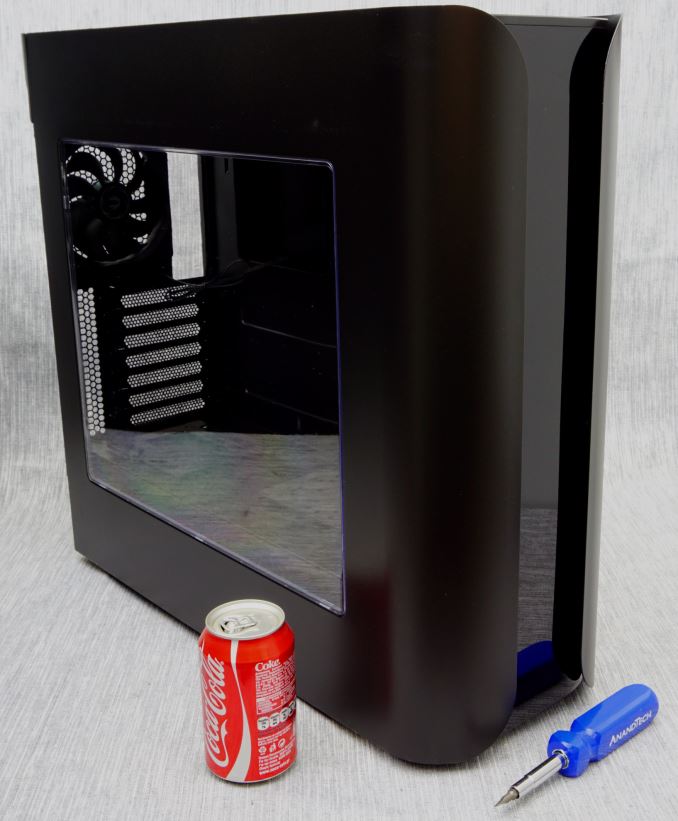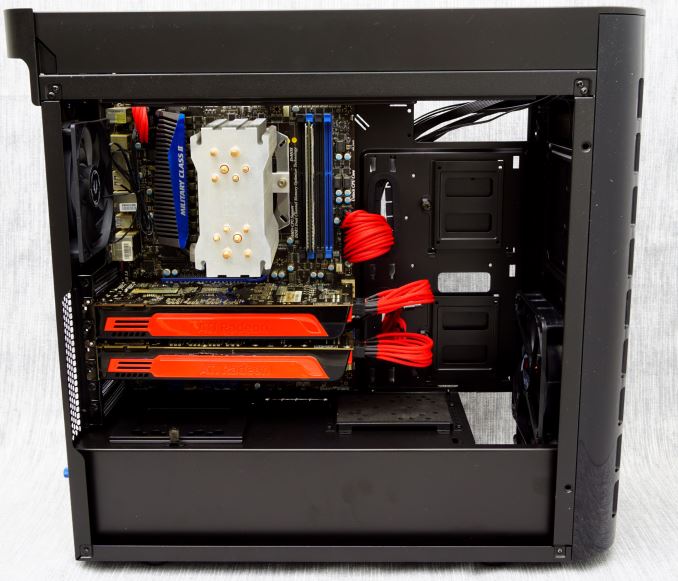The BitFenix Pandora ATX Case Review
by E. Fylladitakis on August 11, 2016 9:00 AM EST- Posted in
- Cases/Cooling/PSUs
- bitfenix
- ATX
- Case
Conclusion
Even though the Pandora ATX is aesthetically based on the original Micro-ATX version of the Pandora, any similarities between the two cases are limited to just their aesthetic design. Where the original version was meant for users who would like a beautiful case for a relatively strong but mainstream PC, the Pandora ATX is directed towards a completely different target group. The size, design, versatility and emphasis on liquid cooling support of the Pandora ATX dictate that it has been designed for users that will be installing very powerful and quite possibly overclocked hardware. The target group that the Pandora ATX is aimed to is very demanding and difficult to please. Even the smallest detail can affect the buyer’s decision and the Pandora ATX is definitely not without flaws.
The primary selling point of the Pandora ATX undoubtedly is, aesthetically speaking, its design. Aesthetics are a subjective matter but it is no secret that the original Pandora was a case loved by modders and users that would place their systems in areas that would make them visible by their friends or guests (e.g. living rooms). It is obvious that BitFenix is trying to replicate this success with the Pandora ATX for users that did not like the limitations of a Micro-ATX build. However, the size of the Pandora ATX is restrictive, as a case this size would look out of place in a simple, modern living room. On the other hand, the roomy case can house powerful hardware and advanced liquid cooling systems, making it ideal for advanced modders and liquid cooling aficionados that want to showcase their work or for large VR systems.
BitFenix tried their best to make the Pandora ATX a versatile case, easing up the work of modders and especially those that plan to install advanced liquid cooling parts. The capability to interchange the front 2.5” and 3.5” trays is interesting, as is the presence of liquid cooling tank and pump supports. The vast majority of commercial liquid cooling parts should be compatible with the Pandora ATX, from large 360 mm radiators to high pressure 12V pumps. The position of the pump mount however creates compatibility issues, as it would most likely block the installation of even a second advanced GPU. It is very strange why the designer did not place this mount down inside the PSU compartment area, where the 3.5” drive trays have been placed. This would limit the number of 3.5” drives, reducing them by at least two, but the pump would stay out of the way of the GPU cards. Those that will be installing more than one GPU will most likely be modifying the case so as to move the pump inside the bottom compartment. Finally, tanks that have been designed for installation in 5.25” device slots obviously are incompatible, as the Pandora ATX does not support 5.25” devices.
The build quality of the Pandora ATX has left us with mixed feelings. It is not uncommon to see cases with mediocre panels on a good chassis or with simple, low quality stock cooling fans installed when designers are trying to cut down the manufacturing costs. In this instance however, it seems as if the designer of the Pandora ATX worked the other way around. The front panel and plastics of the case are of excellent quality and very high quality FDB bearing cooling fans have been installed, whereas the chassis and side panels are relatively thin and weak for a case of this size. It is likely that BitFenix is using the same materials and thickness as with the original Pandora, which was significantly smaller and lighter. The result is a rather malleable chassis that could face permanent damage if mishandled with heavy hardware installed into it and side panels that are susceptible to dents, especially on the flaps extending in front of the case.
In our opinion, the greatest advantage of the Pandora ATX against the competition is its retail price. The case can be found for $112 including shipping at the time of this review, a very fair price for its size, versatility and features. There are few cases of this size at this price point where the designer emphasises on aesthetics and, at the same time, provides exceptional support for advanced liquid cooling setups. We feel that the Pandora ATX will become a favourite among enthusiasts that are building powerful, liquid cooled gaming systems and want to create an aesthetically pleasing result with relatively low effort and custom modifications.












26 Comments
View All Comments
fanofanand - Thursday, August 11, 2016 - link
I understand that everything is designed to a price point, but how much more expensive could it have possibly been to go with all USB 3.0 instead of the 2 USB 2.0 ports? With backwards compatibility this makes no sense to me. USB 3.0 debuted at the end of 2009, we are talking almost 7 years here, I simply cannot understand this decision.woggs - Thursday, August 11, 2016 - link
All motherboards still have USB2.0 sockets and very few have more than one USB3.0 for the front panel. I was happy to see they put both because both is useful for the vast majority of folks. And, I wonder if they would sell you a USB3 replacement for those if you happen to have 2 USB3 sockets on your MB.fanofanand - Thursday, August 11, 2016 - link
I understand that all motherboards have 2.0 sockets but that is again, borne out of cost. With backwards compatibility there is literally zero reason for this. I understand why some legacy ports remain, like PS/2 (many cannot access the bios with a USB keyboard) but with USB it makes no sense. You say "I was happy to see they put both because both is (sic) useful" but there is literally no benefit to USB 2.0 over USB 3.0. I am unaware of a single device that works on USB 2.0 but not 3.0.DanNeely - Thursday, August 11, 2016 - link
I'd be happy if case makers would just offer double header cables with a USB3 and USB2 header on the end. If you've only got one 3.0 header on your mobo it's not that hard to remember which pair of ports are faster; and it gives full support if you've got two 3.x headers. For a forward looking setup today at least one C port would be nice; maybe 2 because actually filling up all 4 front ports isn't that common and it'd give better future proofing.Wider support from the mobo vendors is needed too. I was able to get 2x headers for my Haswell build; but that requirement severely limited my available mobo vendors (I ended up with an MSI board). (I also went with a Case Labs case that used a painted to match 3.5" bay device for its front panel support so that I can easily switch to a setup with C ports in the future; but realize that their cases are far to expensive for the average enthusiast.)
slyronit - Friday, September 2, 2016 - link
On my desktop PC, WIndows device recovery tool cannot flash my Lumia 950XL if it is connected to a USB 3.0 port (either on the front panel or the rear motherboard port). This has happened across Windows 8, 8.1 and now Windows 10, chipset/USB drivers always updated (Tried both the drivers from Windows Update and the Asus drivers). But for such cases, I can make do with a rear USB port.slyronit - Friday, September 2, 2016 - link
And this is all the more surprising, because the phone itself supports USB 3.0 and when connected to my SP3 dock USB 3.0 port, there's a noticeable speed improvement, compared to USB 2.0.RaichuPls - Thursday, August 11, 2016 - link
Some wireless mice/headsets don't play well with USB3.0, such as the Logitech G930 and G602. In my case, interference from USB3.0 ports severely reduce the wireless range of both.eek2121 - Thursday, August 11, 2016 - link
I have 2 devices that don't work with USB 3.0. A headset as well as a high end microphone. The need for USB 2.0 still exists. Manufacturers are aware of this and that's why they haven't dropped USB 2.0. Believe me, if manufacturers could drop USB 2 they would. Going all USB 3.0 would actually LOWER costs.fanofanand - Thursday, August 11, 2016 - link
Thank you eek and Raichu, I was unaware of those issues. I do stand corrected. :) How's this, I wish motherboard makers would at least provide an option with no legacy ports. For those completing a new build, the less legacy the better.kaidenshi - Sunday, August 14, 2016 - link
USB 3.0 isn't 100% backwards compatible across all devices, though. There are some USB 2.0 devices out there that don't enumerate properly or tend to lose communication when plugged into a USB 3.0 socket. Usually the product's support site will have a KB entry about this, and they will suggest using a 2.0 port. I've personally had this issue with a couple of different USB flash drives and with an Android cellphone.In short, USB 2.0 on a case in 2016 is a positive, not a negative thing.